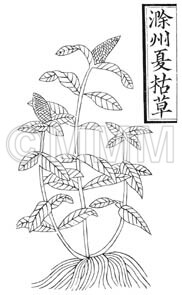Crude drug sample data base
※Click on the image to enlarge it.
Scientific information data base
| Common name | 夏枯草, Xiakucao, Prunellae Spica (JP18, CP2020), Prunella Spike (JP18), Commom Selfheal Fruit-Spike (CP2020) | |||||
|---|---|---|---|---|---|---|
| crude drug image |
| |||||
| Original plant name | Prunella vulgaris Linné var. lilacina Nakai (= Prunella vulgaris Linné subsp. asiatica H. Hara), (Utsubogusa) | |||||
| original plant image |
| |||||
| Family name | Labiatae | |||||
| Used part | spike or whole plant | |||||
| Quality for selection | Good Xiakucao is well-proportioned, brown and consists of spikes only. The one laced with leaves or stem is not good. (TN) Xiakucao produced in Nanjing Jiangsu Prov. is high quality. | |||||
| Official compendium | JP XVIII, CP (2020 ed.) | |||||
| Clinical application | As an antihypertensive diuretic and antiinflammatory, Xiakucao is applied for edema, oliguria, gonorrhea and cervical tuberculous lymphadenitis. | |||||
| Medical system | Traditional Chinese medicine | |||||
| Drug effect in traditional medicine | Traditional classification | Drugs for reducing intense internal heat | ||||
| Beneficial effect | [Property and Flavor] Cold; pungent, bitter. [Meridian Tropism] Liver and gallbladder meridians. [Actions] To clear the liver and purge fire, improve vision, dissipate binds and disperse swelling. [Indications] Red painful swelling eyes, eyeball pain at night, headache and dizziness, scrofula, goiter, acute mastitis , mammary hyperplasia, distending pain in the breasts. | |||||
| Chemical constituent | Other aliphatic and related compounds P. vulgaris subsp. asiatica (*C1): 有機酸/organic acid Triterpenoids P. vulgaris subsp. asiatica (*C1): Ursolic acid, Prunellin, Fenchone Steroids Ajuga decumbens (*C1): Ajugalactone, Ajugasterone B, Ajugasterone C Sterols Ajuga bracteosa (*C1): beta-Sitosterol, gamma-Sitosterol Ecdysones & Phytoecdysones Ajuga decumbens (*C1): beta-Ecdysone, Cyasterone Flavonoids P. vulgaris subsp. asiatica (*C1): フラボノイド Tannins P. vulgaris subsp. asiatica (*C1): タンニン Other alkaloids Ajuga bracteosa (*C1): アルカロイド様の心臓興奮作用物質/alkaloid-like cardio-excitator substance Others P. vulgaris subsp. asiatica (*C1): カリウム塩/potassium salt | |||||
| Chemical structure |
※画像をクリックすると、拡大して表示されます。 | |||||
| Pharmacological effect | Weak cardiotonic and diuresis (ursolic acid,prunellin). | |||||
| Classical reference (Chinese Herbal Classic "Zhenglei bencao") |  ※Click this image to see the actual image ※Click this image to see the actual image | |||||
| Disease | Red eye, Headache, Vertigo, Restlessness, Eye pain, Tuberculous lymphadenitis, Goiter, Mastadenoma, Tumor of the parotid gland, Edema, Oliguria, Gonorrhea | |||||
| Formulation | Kagosoto | |||||
| Related drugs | Dokagosō (Korean Kagosō): the whole plant of Thesium chinense Turcz.,Hakumokagosō: the whole plant of Ajuga decumbens Thunb. | |||||
| References | JP18: The 18th edition of the Japanese Pharmacopoeia. CP2020: Pharmacopoeia of the People's Republic of China 2020 edi. C1)The Encyclopedia of Wakan-Yaku with Color Pictures Vol. II, pp 119-121. | |||||
| Remarks | A part of Korean Xiakucao is the whole plant of Thesium chinense Turcz. of family Santalaceae (Jap. name: Kanabikisō) which is also called Dokagosō (Jap. neme). Hakumokagosō, produced in China, is the whole plant of Ajuga decumbens Thunb. of family Labiatae (Jap. name: Kiransō) or other Ajuga genus. In a part of Yunnan Prov., the whole plant ofA. bracteosa Wall. is called Xiakucao. In Japan, Kinransō is a folk medicine for gastro-intestine and skin boils, and used as a bath agent. | |||||
| Last renewal date | 2021/09/27 | |||||










